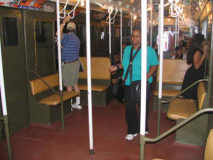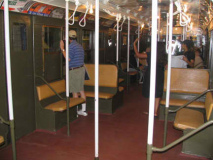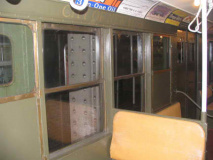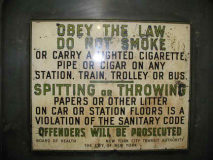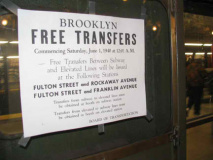As Ray Davies puts it on a song on the Kinks’ Village Green Preservation Society LP,
People take pictures of each other
Just to prove that they really existed
I’d seen photos of the wooden elevated cars that ran on Brooklyn Rapid Transit and later, Brooklyn-Manhattan Transit, and I had even stood in them in the NYC Transit Museum. But a part of me never believed that cars like these actually ran. Those doubts were dispelled forever in the summer of 2004, when the Museum trotted them out on real live tracks and ran ’em to the Rockaways.
Unlike the dinosaurs, we have pictures that proved they existed, and just like “Jurassic Park”, they’ve come back to life!
A September 2004 fan trip run by the Transit Museum united several eras of rapid transit. A consist of R1, R4 and R7 cars were yoked to 3 BRT Elevated cars built in 1907. The train departed from Columbus Circle and travelled to the Transit Museum, then joined the A line and then crossed Jamaica Bay to Rockaway Park. The mostly-IND route was appropriate, since the R1, R4 and R7 all date to the earliest days of the Independent Subway, planned in the 1920s and built between 1925 and 1940 to reduce crowding on the older Brooklyn-Manhattan Transit, a line that had lineage to the earliest days of the Brooklyn elevated trains that began operation in 1885.
The above photo shows R-1 car No. 100 at Rockaway Park during the trip; the photo at right, from Headlights Magazine (official publication of the Electric Railroaders Association), March-April 1994, shows it at the 207th Street Yard in Inwood in upper Manhattan in 1930–a time when the 8th Avenue Line, on which it would run, was still under construction.
R-1 cars, introduced officially in 1932 when the IND 8th Avenue line opened for business, were 60 feet long and contained 60 seats in a mix of cross and lengthwise seating. At this time, seats were still made of rattan and handholds and “straps” (we’ll see real straps presently) were white porcelain.
The “free transfer” poster dates to the cutting back of the Fulton Street el. The el, dating back to the late 1800s, ran along Fulton, Van Sinderen, Snediker, Pitkin, Euclid and Liberty Avenues out to Lefferts Boulevard in Ozone Park. By 1940, the new IND subway under Fulton was well established and el patronage was beginning to decline rapidly, Therefore, the el was cut back to Rockaway Avenue with all el trackage west of that point being razed. El passengers could then transfer for free at that point.
Likewise, a vary small section of the Fulton el was retained at Franklin Avenue to allow a free transfer from the IND to the Franklin Avenue Shuttle; the shuttle ran on an elevated trestle at that point and the structure had to be kept in place. Amazingly, that one small piece of the Fulton el remained until 1998, when reconstruction of the shuttle finally spelled its doom.
In 1956, the Liberty Avenue section of the Fulton El was saved by the city when it was decided to tie the IND Fulton Street line to it from its original terminal at Euclid Avenue. Connecting trackage and a new station at Grant Avenue were constructed. In 1952, NYC purchased the right-of-way of the Long Island Rail Road over Jamaica Bay to the Rockaway peninsula for $8.5M. A new bridge, replacing an oft-burned wooden one, was built and the subways arrived in the Rockaways, with branches to Rockaway Park and Wavecrest (and later to Far Rockaway) in 1956. That would be the last year of significant subway expansion to date: while there’s always talk of building a Flushing Line extension to the West Side and a new Second Avenue line, I suspect that will be just talk for a long time to come.
Early BMT and IRT cars were cooled by overhead ceiling fans, which were surprisingly effective. Later cars, beginning with the R-10 series, placed much smaller fans on the sides of the cars, rendering them much more ineffective. It wasn’t till 2003 that air-conditioning became universal in the subways…most R33 and R36 consists on the #7 Flushing Line still had a car or two without AC! I remember in a roaring 2000 heat wave walking through three #7 cars before getting an air-conditioned one. These fans were running: my camera is fast enough to catch up to it.
Our fantrip also featured two in the R4 series, #401 and #484, seen at Rockaway Park with “railfan window” devotees. The R4s were virtually identical to the R1s, but were outfitted with “bullseye” lighting (in glass diffusers) and an early public address system. The R1s and R4s served on IND and BMT lines until the mid-1970s.
R7 model #1575 also made the voyage. Dating to 1938, the 1575 originally resembled other cars of the R1-R9 period, but after an accident in 1946 it was refitted as an R10 prototype car. Further adjustments have added metal “straps” and fluorescent lighting. The “Hudson Terminal” on the roll sign refers to what is now called the World Trade Center station.
The stars of the show, however, without question, were the BRT self-propelled elevated cars, manufactured in 1907 by the Jewett Car Company in Newark, Ohio, and Laconia in Laconia, New Hampshire; they were originally numbered #1273, 1404 and 1407 and built with wooden exteriors mounted on steel underframes.
In reality, these cars are not in their original condition. In 1937, the 40’5″ cars, after 30 years of service on various Brooklyn elevated lines, were taken out of service and rehabbed as BMT “Q” cars and placed on the Flushing Line (as seen in the photo taken at the Transit Museum by Frank Hicks), then operated jointly by the BMT and IRT, and given the 1939 World’s Fair blue and orange paint scheme and given side doors. In 1979, the cars were rehabilitated back to their original configuration.
These early elevated cars are referred to as “gate” cars because they had no doors that opened to platforms. Each car had an open platform on either end, each manned by a conductor contolling steel gates, who would ring a ceiling-mouted bell when passengers were safely onboard. When every bell had rung, the motorman would get the all-clear to proceed. the wire connected to the bell can be seen in the photo to the upper right. Note the cut-glass “BRT” on the cab door. This is a later addition and was not featured when the trains originally ran.
The Brooklyn els cars never saw service across Jamaica Bay to the Rockaways; only Long Island rail Road cars traversed the bay between the late 1800s and 1950.
1930s porcelain and 1900s canvas straps. These straps were actually added in 1979 when the car was rebuilt, but they are faithful reproductions.
In the days before roll signs, metal signs fit into slats built into the windows. Note the small letters above the signs: they were used to easily find which sign was which when they were likely stored in a drawer or cabinet. Also note that the cars ran on the Flushing Line, jointly operated by the BMT and IRT until 1949 when the Astoria Line was converted for BMT use and the Flushing Line went to the IRT.
Early 20th Century ads are reproduced in the gate cars. The Sunkist name has been in use since 1908 and the company has been around since 1893. The un-pc ad next to it dates to before women’s suffrage in 1920. At right..if it’s “almost a Kodak”…why plug the other guys? R44 car #5342 can be seen outside the window.
Like its successor cars, the gate cars combine cross and lengthwise seating, with a roominess lacking from later cars. Ample glass let a lot of light into the cars, which in their later years never saw passenger service in subway tunnels due to fire regulations. The cars were in service decades before barbed wire was de rigueur in train yards.
10/17/04



